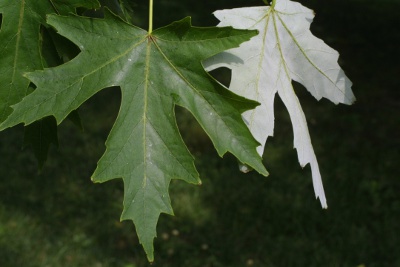Silver Maple Tree
Category: Deciduous Trees

Facts about Silver Maple Tree, "Scientific name for Silver Maple Tree is Acer saccharinum". The Silver Maple tree holds the ability to survive in a wide variety of soil conditions. When it is scraped or broken, it generates a strong foul odor. The Silver Maple Tree grows rapidly and attains maturity earlier than most of the Maple trees.
Few distinguishing features of the Silver Maple Tree have been described here.
The Silver Maple Tree grows can grow up to 70 to 100 feet (21.33 to 30.48 meters) height. It is the most commonly damaged Maple during a storms as it has a brittle wood. If the Silver Maple Tree could survive through all the high speed wind incidents, it may live up to 130 to 150 years.
Habitat of Silver Maple Tree
While the commonly mentioned habitat for Silver Maple Tree is Eastern North America, it is only found in South Eastern Canada. It also grows in East coasts of United States. Other areas include Georgia and western portion of Kansas.
Bark of Silver Maple Tree
The bark of young Silver Maple Trees is usually grey and it may have a reddish tint at times. The matured Silver Maple Trees have long, thin, scale like plates in their bark that may bring a shaggy look to itself. However, the bark in matured Silver Maple Trees is of reddish brown in color.
Leaf of Silver Maple Tree
Leaves of Silver Maple are 5 to 7 inches (12.7 to 17.7 cm) long. They have 5 lobes and the margins of the leaves have fine teeth. The name of the Silver Maple Tree is derived from the look of the leaves from the matured trees. They are pale green with a silvery underside that gives a shiny look when watched from the ground. A Full grown Silver Maple Tree can absorb as much as 48 pounds (21.77 kg) of carbon dioxide a year. The same Silver Maple Tree could also produce enough oxygen in a day for two people. In a single day, a large Silver Maple Tree can drink up to 100 gallons (378.5 liter) of water from the ground and discharge it into the air.
You can tell a Silver Maple Trees age by the number of growth rings. Growth rings size shows what kind of conditions accrued that year, the temperature and if it was a dry or wet year.
Bark of the Silver Maple Tree protects it from the elements and is made up of dead cells.
Silver Maple Tree roots usually grow two to three times the width of the tree branches. The ideal time to fertilize your Silver Maple Tree is in late fall or early spring. If you want to transplant a tree do it in fall, this is ideal for most trees.
Twig/Bud of Silver Maple Tree
Not only the branches, but also the twigs give a foul odor upon breaking. Buds appearing in winter are bigger than that of Red Maple. The Silver Maple Tree are conical and brown in color, just like red Maple.
Silver Maple Tree leaves are made up of many colored pigments, green chlorophyll hides the colors during the growing season of spring and summer. As days get Shorter and cooler temperatures come in the fall, it cause the chlorophyll to break down and than the other color pigments can be seen.
Silver Maple Tree growth is referred to as Meristem (The undifferentiated embryonic plant tissue from which new cells are created, as that at the tip of a root or stem). This tissue can be found at the tips of shoots and leaves. Inside the stem growth in thickness occurs at the vascular cambium.
Silver Maple Trees make their own food from sunlight, carbon dioxide, water, and nutrients from the soil.
Fruit of Silver Maple Tree
The fruit has two wings in its both sides and it develops in clusters. They may vary from 1/2 to 2 inches in length. The silver maples tree matures in spring. Usually, one of the fruits that develops as a twin, is less developed.

 Back To Category Deciduous Trees
Back To Category Deciduous Trees